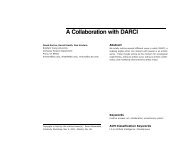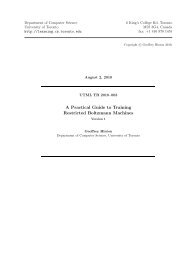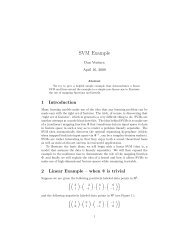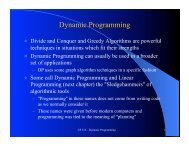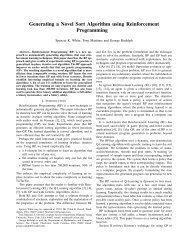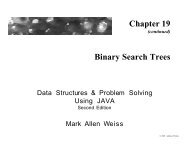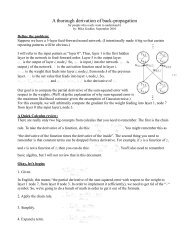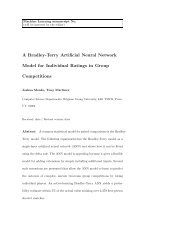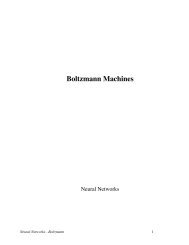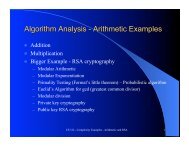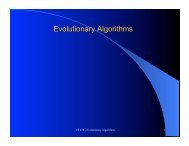Norton - Neural Networks and Machine Learning Lab - Brigham ...
Norton - Neural Networks and Machine Learning Lab - Brigham ...
Norton - Neural Networks and Machine Learning Lab - Brigham ...
You also want an ePaper? Increase the reach of your titles
YUMPU automatically turns print PDFs into web optimized ePapers that Google loves.
Fig. 1 Diagram of a liquid state machine. (a, b) The input signal is transformed into a series of spikes via some function.<br />
(c) The spike train is introduced into the neural microcircuit, or “liquid”. (d) Snapshots of the state of the “liquid” are<br />
recorded in state vectors. (e) The state vectors are used as input to train a learning algorithm, the reading function.<br />
proportion to the temporal correlation between the pre- <strong>and</strong><br />
post-synaptic neurons. If the pre-synaptic neuron fires first,<br />
then the weight is increased; if the post-synaptic neuron fires<br />
first then the weight is decreased. In this way, synapses that<br />
participate in a neuron’s breach of threshold (resulting in a<br />
spike) are strengthened while those that don’t are weakened<br />
[1]. We will refer to an LSM that uses STDP synapses as a<br />
Hebbian Liquid State <strong>Machine</strong> (HLSM).<br />
B. Separation<br />
The effectiveness of an LSM is a function of two<br />
qualities: the approximation <strong>and</strong> the separation of the LSM.<br />
Approximation refers to the reading function’s ability to<br />
classify the state vectors acquired from the liquid.<br />
Separation refers to “the amount of separation between<br />
trajectories of internal states of the system that are caused by<br />
two different input streams” [5]; or in other words, the<br />
ability of the liquid to produce discernibly different patterns<br />
when given different classes of inputs. Since any machine<br />
learning algorithm can be used for the reading function, this<br />
paper focuses on improving the separation attribute of the<br />
LSM.<br />
In order to measure the separation of a liquid we use the<br />
following definition presented first by Goodman [6]:<br />
N N Cm<br />
( Oi<br />
) − Cm<br />
( O<br />
j<br />
)<br />
2<br />
Sep(Ψ , O)<br />
= ∑∑<br />
2<br />
i= 1 j= 1 N<br />
where Ψ is a neural microcircuit (or liquid), O is a set of<br />
state vectors, <strong>and</strong> N is the total number of output classes<br />
represented by O. O is divided into N subsets each of which<br />
contains all elements of O belonging to a common output<br />
class. The center of mass, C for each subset is calculated<br />
m<br />
as follows:<br />
∑ o<br />
j<br />
o j ∈O<br />
C<br />
m<br />
( Oi<br />
) =<br />
O<br />
i<br />
The Euclidean distance between every pair wise<br />
combination of center of mass vectors is determined. Each<br />
center of mass is the estimate of the representative state<br />
vector for each output class. The ideal liquid would separate<br />
the state vectors for each output class into distinct clusters<br />
within the vector space. Goodman's research indicates that<br />
there is a positive correlation between this separation<br />
measure <strong>and</strong> the accuracy of the LSM [6].<br />
There are certain negative behaviors common in LSMs<br />
that can significantly decrease their separation. These<br />
behaviors are termed pathological synchrony <strong>and</strong> overstratification.<br />
Pathological synchrony occurs when most of<br />
the neurons in the liquid get caught in infinite positive<br />
feedback loops with respect to their firing. These infinite<br />
loops continuously influence the state of the liquid<br />
overriding the flow of information from the input. In<br />
extreme cases the entire liquid can begin firing continuously<br />
in synchrony (see Fig. 2). Such liquids have low separation<br />
because of the loss of pattern associated with such crowded<br />
spiking.<br />
The opposite extreme is over-stratification—when groups<br />
of neurons do not propagate a series of spikes induced by an<br />
input spike long enough. In these cases, input spikes do not<br />
influence each other within the liquid, thus resulting in a loss<br />
of temporal coherency that can be represented by the liquid<br />
(see Fig. 3). Since both of these features are detrimental to<br />
the effectiveness of LSMs, this study emphasizes<br />
eliminating them.<br />
III. RESULTS<br />
Two experiments were performed in order to observe how<br />
Hebbian learning affects the structure <strong>and</strong> separation of<br />
liquids. R<strong>and</strong>om input was introduced into the liquid for the<br />
first experiment while speech data was used as input for the<br />
second experiment. Also, Hebbian learning was compared



